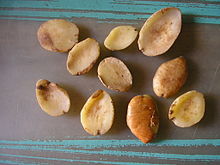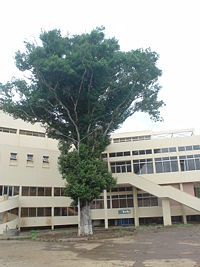
Sorghum or broomcorn is a genus of about 25 species of flowering plants in the grass family (Poaceae). Sorghum bicolor is grown as a cereal for human consumption and as animal fodder.

Mangifera is a genus of flowering plants in the cashew family, Anacardiaceae. It contains 64 species, with the best-known being the common mango. The center of diversity of the genus is in the Malesian ecoregion of Southeast Asia, particularly in Sumatra, Borneo, and the Malay Peninsula. They are generally canopy trees in lowland rainforests, reaching a height of 30–40 m (98–131 ft).

Oryza is a genus of plants in the grass family. It includes the major food crop rice. Members of the genus grow as tall, wetland grasses, growing to 1–2 metres (3–7 ft) tall; the genus includes both annual and perennial species.

Hickory is a common name for trees composing the genus Carya, which includes 19 species accepted by Plants of the World Online.

Delonix is a genus of flowering plants in the family Fabaceae, subfamily Caesalpinioideae. It contains trees that are native to Madagascar and East Africa. By far the best known species is the Royal Poinciana.

Croton is an extensive plant genus in the spurge family, Euphorbiaceae. The plants of this genus were described and introduced to Europeans by Georg Eberhard Rumphius. The common names for this genus are rushfoil and croton, but the latter also refers to Codiaeum variegatum. The generic name comes from the Greek κρότος, which means "tick" and refers to the shape of the seeds of certain species.
Apodiscus is a genus of trees belonging to the family Phyllanthaceae first described as a genus in 1912. It contains only one known species, Apodiscus chevalieri, native to tropical West Africa.
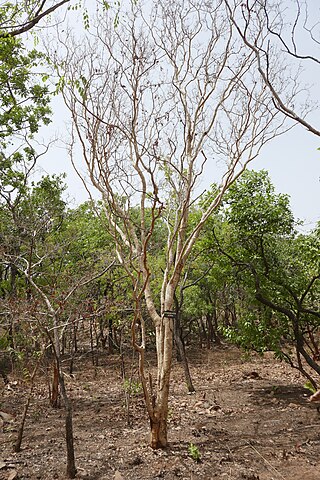
Hymenocardia is a genus of trees in the family Phyllanthaceae first described as a genus in 1836. Most of the species are native to Africa, with one in Southeast Asia.
Eliea is a genus of flowering plants, shrubs or small trees, in the St. Johnswort family, Hypericaceae. It comprises a single species, Eliea articulata, which is endemic to Madagascar.
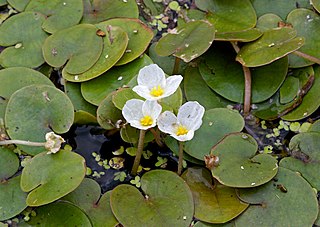
Hydrocharis is a genus of aquatic plants in the family Hydrocharitaceae described as a genus by Carl Linnaeus in 1753. It is widespread across much of Europe and Asia, plus a few scattered locations in Africa. It is also reportedly naturalized in parts of North America.

Irvingia gabonensis is a species of African trees in the genus Irvingia, sometimes known by the common names wild mango, African mango, or bush mango. They bear edible mango-like fruits, and are especially valued for their fat- and protein-rich nuts.
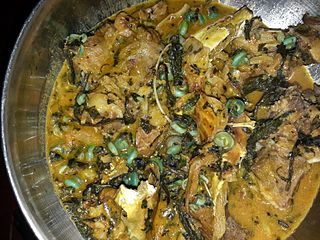
Ogbono Soup is a Nigerian dish made with ground dry ogbono seeds. Ogbono seeds are originated and were first grown in Southern Nigeria with considerable local variation. According to research by Chris Chinaka and J.C. Obiefuna, Ogbono is an indigenous forest tree associated with plants classified as 'non-timber forest products. It goes by various indigenous names among Nigerians. The Common use of the word “ogbono” in general Nigerian parlance stems from the Igbo name for the word. Among the Nupe, it is called 'pekpeara', 'ogwi' in Bini, 'uyo' in Efik, and 'oro' or ‘apon’ in Yoruba. Although ogbono and ugiri, the Igbo name for bush-mango, are very similar indeed and often regarded as equivalents, there is technically a distinction.

Thalassodendron is a genus of seagrass in the family Cymodoceaceae, described as a genus in 1970. It grows along the shores of the Indian Ocean, the western Pacific Ocean and around Australasia.

Syringodium is a genus in the family Cymodoceaceae described as a genus in 1860. It is found along shorelines of tropical and subtropical marine environments.

Halodule is a genus of plants in the family Cymodoceaceae described as a genus in 1841. It is widespread on tropical and semi-tropical ocean shores of all continents except Europe and Antarctica.

Mangifera indica, commonly known as mango, is an evergreen species of flowering plant in the family Anacardiaceae. It is a large fruit tree, capable of growing to a height and width of 30 metres. There are two distinct genetic populations in modern mangoes – the "Indian type" and the "Southeast Asian type".

Coix is a genus of Asian and Australian plants in the grass family.

Irvingia malayana, also known as wild almond or barking deer’s mango, is a tropical evergreen tree species in the family Irvingiaceae. The specific epithet malayana is from the Latin meaning "of Malaya".

Blyxa is a genus of an aquatic plant of the family Hydrocharitaceae described as a genus in 1806.
